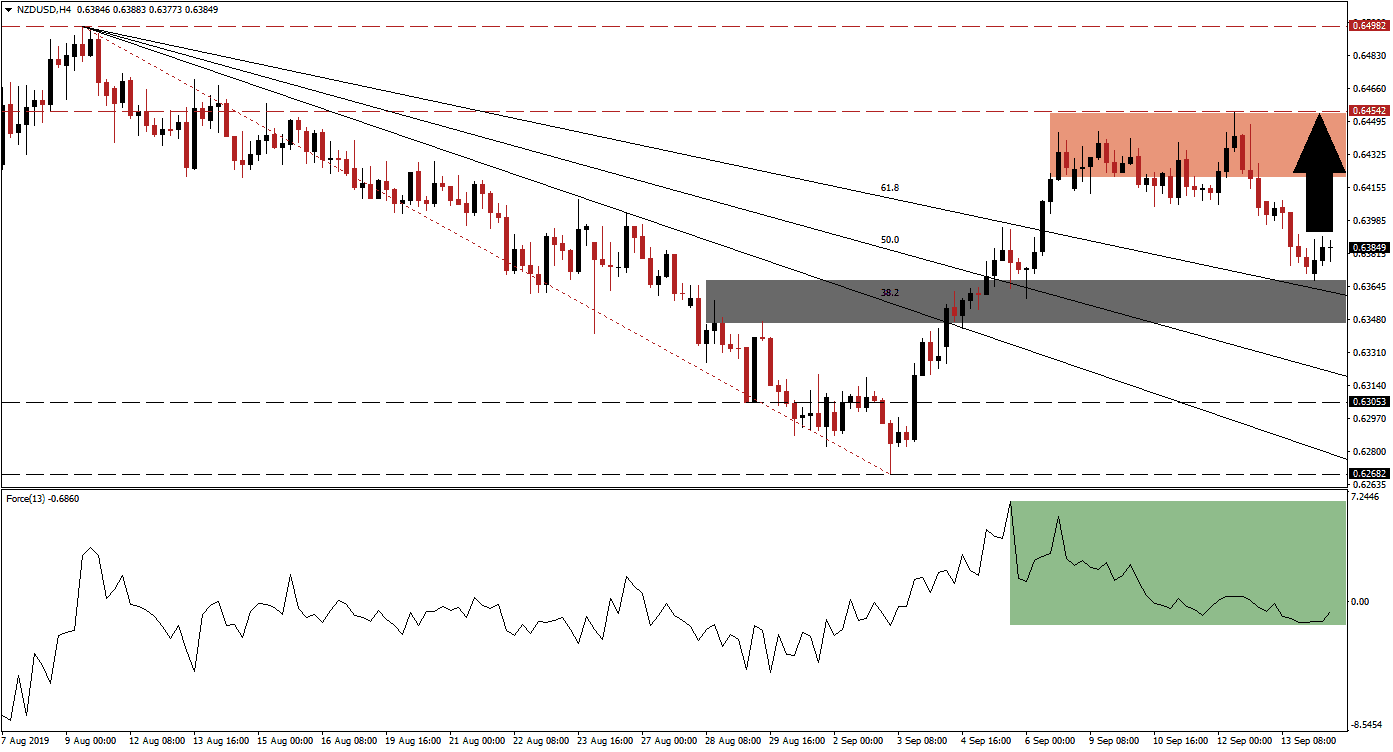After a strong rally which took the NZD/USD from its support zone through its 38.2, 50.0 and 61.8 Fibonacci Retracement Fan Resistance Levels, price action has struggled to keep the uptrend alive. This currency pair reached the bottom of a long-term resistance zone at 0.64542 which also marks the top range of its current short-term resistance zone. Price action reversed to the downside as bearish momentum rose until this currency pair reached its 61.8 Fibonacci Retracement Fan Support Level, which was turned from resistance to support following the breakout above it. The sell-off how now paused and bearish momentum is being depleted.
What is the Fibonacci Retracement Fan?
The Fibonacci Retracement Fan is a different visualization of the Fibonacci retracement sequence which outlines important support and resistance levels in technical analysis. Those levels warrant a closer look and offer entry and exit levels for trades together with other aspects of the analysis.
The Force Index, a next generation technical indicator, started to stabilize just after it dropped below the 0 center line which is marked by the green rectangle. This confirms that bearish momentum is losing is strength and this technical indicator has started to inch upwards. A sustained move back into positive territory would place bulls in control of price action. Together with the NZD/USD at its 61.8 Fibonacci Retracement Fan Support Level, this could lead to a renewed advance. The level of the Force Index should now be closely monitored as it could provide the next bullish trading signal.
What is the Force Index?
The force index is considered a next generation technical indicator. As the name suggests, it measures the force behind a move. In other words, forex traders will get a better idea behind the strength of bullish or bearish pressures which are driving price action. The indicator consist of three components (directional change of the price, the degree of the change and the trading volume). This creates an oscillator which in conjunction with other aspects of technical analysis provides a good indicator for potential changes in the direction of price action. It subtracts the previous day closing price from today’s closing price and multiplies it by the volume. Strong moves are supported by volume and create the most accurate trading signals.
The most recent intra-day low of 0.63680 marks the top range of its horizontal support zone with the bottom range located at 0.63469, marked by the grey rectangle. This narrow support zone is currently housing the descending 61.8 Fibonacci Retracement Fan Support Level. While this morning’s disappointing Chinese economic data provided a bearish boost to the new Zealand Dollar, a commodity currency which is also exposed to the Chinese economy as well as to the Australian one, the cloud of this week’s US Federal Reserve meeting where another interest rate cut is expected is keeping a lid on US Dollar strength. The current support zone is expected to hold and provide a platform a another price action reversal.
What is a Support Zone?
A support zone is a price range where bearish momentum is receding and bullish momentum is advancing. They can identify areas where price action has a chance to reverse to the upside and a support zone offers a more reliable technical snapshot than a single price point such as an intra-day low.
While a move down into its 61.8 Fibonacci Retracement Fan Support Level cannot be ruled out, this should be viewed as a good entry opportunity into a NZD/USD long position if the Force Index doesn’t record a new low since the downtrend started. A successful test of support could ignite a short-covering rally which will take price action back into its short-term resistance zone located between 0.64226 and 0.64524, marked by the red rectangle.
What is a Short-Covering Rally?
A short-covering rally refers to traders covering short positions which is done by buying the underlying asset which was previously borrowed for the trade from a third-party. When a short order is placed, traders borrow the asset from a third party and sell it in the market. Once price action declines it is bought back at a lower price and returned to the third-party which creates a short-covering rally, a counter-trend move.
NZD/USD Technical Trading Set-Up - Reversal Scenario
Long Entry @ 0.63750
Take Profit @ 0.64500
Stop Loss @ 0.63450
Upside Potential: 75 pips
Downside Risk: 30 pips
Risk/Reward Ratio: 2.50
A new low in the Force Index could push the NZD/USD below its 61.8 Fibonacci Retracement Fan Support Level and the breakout may extend through its short-term support zone. A move below its intra-day low of 0.63469, the bottom range of its support zone, could extend the sell-off its long-term support zone located between 0.62682 and 0.63053. In order for this event to materialize, a new fundamental catalyst is required or a breakdown in the current technical picture which favors an advance in this currency pair.
What is a Breakdown?
A breakdown is the opposite of a breakout and occurs when price action moves below a support or resistance zone. A breakdown below a resistance zone could suggest a short-term move such as profit taking by forex traders or a long-term move such as a trend reversal from bullish to bearish. A breakdown below a support zone indicates a strong bearish trend and the extension of the downtrend.
NZD/USD Technical Trading Set-Up - Breakdown Scenario
Short Entry @ 0.63300
Take Profit @ 0.62750
Stop Loss @ 0.63550
Downside Potential: 55 pips
Upside Risk: 25 pips
Risk/Reward Ratio: 2.20

